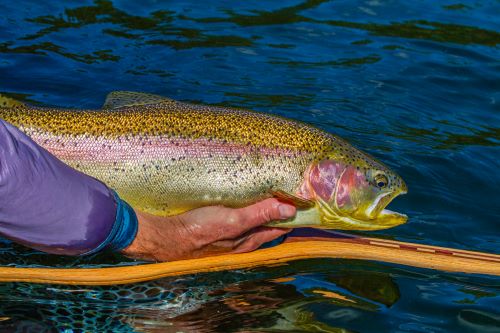Origin: The Horsefly strain of rainbow trout originates from the Horsefly River and Quesnel Lake (the deepest lake in British Columbia, and a major tributary of the Fraser River). It is the newest strain of rainbow trout stocked by the Freshwater Fisheries Society of BC.
Habitat: These opportunistic rainbow trout are known for their large size in their natal environment. In the Quesnel Lake system, they move into rivers seasonally to feed on salmon eggs and fry, along with invertebrates, and then back out to the lake to feed on kokanee. Competing against two species of char (lake and bull trout), they are the dominant predators in Quesnel Lake. Similar to the Blackwater strain, these aggressive trout thrive in environments where they’re in competition with other species; they are better suited than other rainbow strains we stock for lakes with non-salmonid fish populations. In small lakes, their diet is similar to that of the Blackwater strain, but does tend to include more fish in lakes with minnow species like the redside shiner and lake chub.
Description: Horsefly strain rainbows exhibit a distinctive golden tone. Typically, they are densely spotted above the lateral line. Where the fishing pressure is low, mature specimens can attain relatively big sizes. In Quesnel Lake, they can attain weights of more than nine kilograms (20 pounds).
Fishing: Horsefly trout will readily take lures and dry flies. When hooked, they are known to jump and fight well. In larger, mixed-species lakes, try using a downrigger and lures that imitate minnows or kokanee. Recent studies have proven that Horsefly rainbows are as catchable as Blackwater trout, and exhibit strong survival after stocking.
